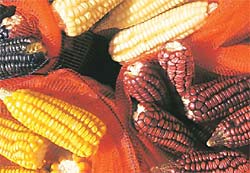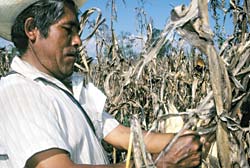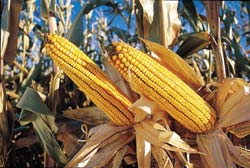
The Magazine of the Pan American Health Organization
Volume 8, Number 3, 2003


Battling over
Biotechnology
by Donal Nugent

By the 1500s, the Incas of Peru had constructed a highly sophisticated, state-supported agricultural system. On stepped mountain terraces bound by stone walls and irrigated by canals, they farmed crops then unknown to Europeans: tomatoes, potatoes, oca, peppers and, in the lowlands, corn and cotton. From wild landraces they created new genetic strains that produced harvests bountiful enough to feed an empire. It was biotechnology as advanced as a Stone Age people could perfect it.
Today, modern Peru takes a more cautious approach to an equally groundbreaking advance in agriculture. Its government has banned the growing of genetically modified (GM) crops because it believes not enough is known about their impact on the environment.
Fifty years ago, the publication of James Watson and Francis Crick's paper identifying the double-helical structure of DNA heralded a new era in science. In 1964, the so-called Green Revolution was kick-started with the introduction into Third World countries of new highyielding varieties of wheat and rice. By 1978, scientists had demonstrated the practical value of biotechnology by producing human insulin through genetically modified bacteria (before this, diabetics depended on the insulin recovered from slaughtered pigs).
In 1994, another milestone followed. The American seed company Monsanto unveiled a new variety of soybean genetically engineered to be resistant to the herbicide glyphosate. Glyphosate is a highly effective herbicide that is particularly attractive from an environmental point of view because it is less toxic than many other herbicides and breaks down more quickly into relatively harmless components. The new soybean would require fewer pesticide applications, facilitate better environmental management and result in greater productivity on farms.
A decade later, biotech crops represent the fastest take-up of new technology in agricultural history. Today 46 percent of the world's soybean crop is GM, as is a quarter of all corn production in the United States.

But not everyone has jumped on the bandwagon. The European Union initially accepted imports of GM corn and soy from the United States until a major consumer backlash prompted a five-year moratorium on any new varieties starting in 1998. This was followed with a decision this year to license GM crops on a case-by-case basis. But many European consumers remain skeptical. As recently as July 18 of this year, the British newspaper The Guardian reported threats of civil unrest if GM crops were planted in Britain.
The U.S.-Europe standoff on GM foods is significant in its own right, but it also affects other countries around the world. Zambia, for example, made international headlines last year when its government rejected GM corn as food aid from the United States out of fears that it might "poison" its citizens and jeopardize its trade relationship with Europe.
Within the Americas, individual countries are aligning themselves on different sides of this GM fence. Latin America's top two food producers provide contrasting examples. Argentina has emerged as the world's secondlargest grower of GM crops, primarily soy but also corn varieties licensed in the European Union. Meanwhile Brazil, the world's second-largest producer of soybeans, until recently refused to license any commercial GM crop varieties. Yet in fact GM soy has been planted widely in certain areas of Brazil because farmers find it more productive and easier to grow than conventional varieties.
Issues at stakeFar more is at issue in this controversial debate than the fears of well-fed consumers in the developed world. According to the United Nations Food and Agriculture Organization (FAO), more than 50 million people worldwide suffer from chronic malnutrition, and proponents argue that GM crops can and should play a critical role in addressing their needs and those of future populations.

Since 2000, the AgBioWorld Foundation has collected signatures from more than 3,200 scientists in support of GM agriculture in the developing world. Among them was Nobel Peace Prize winner Norman Borlaug, the father of the Green Revolution.
"The majority of agricultural scientists, including myself, anticipate great benefits from biotechnology in the coming decades to help meet our future needs for food and fiber," Borlaug wrote in the October 2000 issue of Plant Physiology.
Critics counter that, hunger notwithstanding, GM foods pose more risks than benefits. Greenpeace charges that GM crops are put in foods despite unknown health risks, that they can produce allergies and antibiotic resistance and that they "genetically contaminate" wild populations and ecosystems.
Most members of the scientific community view such claims as unfounded or wildly exaggerated. The American Society of Toxicology said in a 2002 position paper: "The available scientific evidence indicates that the potential adverse health effects arising from biotechnology-derived foods are not different in nature from those created by conventional breeding practices.… It is therefore important to recognize that it is the food product itself, rather than the process through which it is made, that should be the focus of attention in assessing safety."
Both sides nowIf biotechnology were the new Cold War, then Chile would be its unlikely Berlin Wall. Isolated between the Pacific Ocean and the Andes mountains, and with a small growing area (only an estimated 3 percent of the country is arable land), Chile has been able to exploit its unique geography to secure niche markets internationally in what seem to be mutually exclusive enterprises, organic foods and GM seeds.
The country has a population of 16 million, of whom approximately 20 percent live below the poverty line. Since 1992, Chilean law has allowed GM seeds to be imported into the country, "multiplied," and then exported, but not planted for food production.
Carlos Muñoz Schick, an agronomist at the National Institute for Agricultural Research, says that Chile's agricultural policy is to increase the country's international market share by developing niche enterprises rather than competing with countries like Argentina and Brazil in commodity products. Toward that end, Chile has introduced nontraditional crops such as kiwifruit, blueberries and organic produce into its food-export basket and, more recently, has begun domesticating wild native fruits such as the murtilla, a richly flavored berry. Within this strategy, biotechnology could play a significant role.
"Biotech may help in developing new market niches, improving the quality of our produce, and even creating new technologies-new cultivars, for instance, better adapted to the Latin American environment," says Muñoz. "Creating new jobs is a must for our economy," he adds.
A similar analysis underlies recent research into the possibility of growing GM salmon in the country. One of the world's biggest suppliers of salmon, Chile is looking at the possibility of breeding a biotech variety that grows four times faster than conventional salmon. The reaction of consumers in export markets will be a deciding factor in its eventual commercialization.
The relationship between GM and organic growers in Chile is not without controversy. The location of GM seed farms has been kept secret by the government since production began in the early 1990s. In January 2002, following litigation by organic producers, a Chilean court ordered the Cattle and Agricultural Service to disclose the location and ownership of fields planted with transgenic crops. That decision is under appeal. The concerns of organic farmers were further heightened later in the year when France returned two batches of maize seed to Chile because they contained transgenic material above the allowed 0.5 percent threshold.
Regional variationsOver the last 13 years, Argentina and Brazil have emerged as major suppliers to the world commodities market. According to U.S. Department of Agriculture (USDA) figures, soybean production has more than doubled in both countries. Argentina's production of wheat and corn has increased by 75 percent and 105 percent, respectively, and Brazil's corn production by 40 percent.

In the late 1990s, Argentina moved from a de facto moratorium on GM crops to becoming the leading commercial GM grower outside the United States. The use of GM cotton was first authorized for the 1996-97 growing season, a move soon followed by the licensing of GM soy. Today 90 percent of Argentina's soybeans are GM, and the country grows corn genetically modified to resist insects and tolerate herbicides.
In Brazil, meanwhile, government policy has been largely opposed to GM crops, even though the country has its own homegrown biotechnology research sector that is globally renowned. As an officially "GM-free" commodities producer, Brazil has emerged as the supplier of choice for many E.U. importers. Yet the reality on the ground has been somewhat different. A 2001 USDA report estimated that 20 percent to 40 percent of soy planted in Brazil's south is GM. Other estimates put the figure at up to 80 percent.
Under mounting pressure, the Brazilian government in September issued an executive decree that allows farmers to plant GM soybeans-but only if they already possess the GM seeds and only during the 2003-2004 growing season. Farmers must also agree to assume financial responsibility for any environmental damage that might result.
Meanwhile, the Brazilian government has allowed researchers to conduct field trials on a wide array of transgenic crops, focusing on insect and virus resistance as well as herbicide tolerance. Government-funded research institutions, an indigenous private biotech sector, and multinational life sciences companies are involved in trials of tobacco, potatoes, sweet corn, papaya and sugarcane, as well as cotton, corn and soybeans.
Future foodsIn global terms, the ratio of commercialized biotech products to those that have been developed in laboratories is something akin to an iceberg above and below water. The U.S.-based International Food Information Council has identified what it terms a "second generation" of biotechenhanced products that could soon find their way to the supermarket shelf. Among them are cooking oils with higher stearate concentrations (and so not requiring hydrogenation), singleserve seedless melons, tomatoes with increased lycopene (a powerful antioxidant), higher-starch potatoes that absorb less fat, and strawberries higher in ellagic acid (a natural cancer-fighting agent). Add to these a host of nonfood products under development as well.
Chile is among the Latin American countries determined not to be left behind in this process. In June 2003, its National Commission for the Development of Biotechnology issued a wide-ranging report on the future of biotechnology in the country. It calls on Chile to seize the opportunity to improve its competitiveness by applying biotechnology in its natural resource sectors. But it also calls for the development of a well-defined regulatory framework to reduce any associated risks.
Other recent developments suggest that biotechnology may be heading toward greater acceptance in Latin America. Brazil, Colombia, Costa Rica, Ecuador, Mexico, Peru, and Venezuela last year all signed the Cancún Declaration of Like-Minded Megadiverse Countries, along with China, India, Indonesia, Kenya and South Africa. The declaration recognizes "the urgent need to develop human resources, institutional capabilities, as well as an appropriate legal framework and public policies, to enable our countries to take an active part in the new economy associated with the use of biological diversity, genetic resources and biotechnology."
In March 2004, Chile will host the world's first Global Biotechnology Forum, cosponsored by the United Nations Industrial Development Organization (UNIDO) and the Chilean government. The event will bring together representatives of government, development agencies, industry, the scientific community and the public to discuss the challenges and opportunities of biotechnology in the developing world. For the countries of the Americas, it could signal a growing shift in focus toward how-not so much if-GM technology can be harnessed to benefit the region and its inhabitants.
Donal Nugent, of Ireland, is the 2003 science journalism fellow at the Council for Agricultural Science and Technology in Washington, D.C.